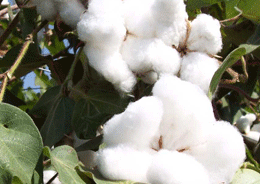
Cotton prices stable; haze over China’s policy
The USDA's latest report featured an increase to global figures for 2014/15 beginning stocks (?,000 bales, to 100.3 million) and production (?,000 bales, to 118.0 million) as well as a decrease to the estimate for world consumption (-479,000 bales, to 112.1 million).
- Although December futures have been testing higher values, they have yet to break decisively above resistance near 68 cents/lb and were range-bound over the past month with values trading between 65 cents/lb and 68 cents/lb.
- The A Index has been flat to slightly higher since early September with values ranging between 73 and 76 cents/lb.
- The CC Index has been stable in international terms, holding to levels near 125 cents/lb. In domestic terms, the CC Index declined from 17,100 RMB/ton to 16,900 RMB/ton over the past month.
- Indian spot prices for the Shankar-6 variety were steady in both international and domestic terms at values near 85 cents/lb or 39,800 INR/candy.
- Pakistani spot prices were unchanged at levels near 67 cents/lb in international terms last month. In domestic terms, prices edged higher and increased from 5,300 PKR/maund to 5,600 PKR/maund.
Supply, demand, & trade
The USDA’s latest report featured an increase to global figures for 2014/15 beginning stocks (?,000 bales, to 100.3 million) and production (?,000 bales, to 118.0 million) as well as a decrease to the estimate for world consumption (-479,000 bales, to 112.1 million). The combination of increased supply and diminished demand resulted in an increase to the forecast for ending stocks (.2 million bales). At 106.3 million bales, the current estimate for 2014/15 ending stocks represents 94.8% of expected mill-use.
At the country-level, the largest revisions to production figures were for the U.S. (-1.0 million bales, to 16.5 million) and India (.0 million bales to 30.0 million). With this month’s addition, India is expected to surpass China as the world’s largest cotton producer this crop year. Other notable changes to production estimates were for Argentina (-100,000 bales, to 1.1 million), Uzbekistan (-100,000 bales, to 4.1 million), Burkina Faso (?,000 bales, to 1.2 million), Cote d’Ivoire (?,000 bales, to 800,000), and Turkey (?,000 bales, to 3.2 million).
In terms of mill-use, the only significant country-level changes were for Pakistan, where decreases were made to figures for 2012/13 (-250,000 bales, to 10.8 million), 2013/14 (-300,000 bales, to 10.4 million), and 2014/15 (-500,000 bales, to 10.5 million).
There were several notable revisions to trade figures that resulted from changes to production estimates. For example, the U.S. export forecast decreased 700,000 bales (to 10.0 million bales) and the Turkish import estimate decreased 250,000 bales (to 3.8 million). For India, changes for production and trade were less correlated, with the increase in the Indian harvest estimate accompanied by decreases for both imports (-300,000 bales, to 800,000) and exports (-100,000 bales, to 5.7 million).
Price outlook
Despite widespread anticipation that news would be available in early September, details regarding the implementation of China’s new cotton policies have yet to be released. A statement issued in early September by the National Development and Reform Commission (NDRC, the government organization responsible for cotton policy), indicated that details will be forthcoming and that the price monitoring process for determining payments to growers is already being implemented. While the specifics related to producer support are relevant to the global market, reserve management, and particularly the price at which cotton might be released from reserves in future auctions, is likely more important to world cotton price direction.
The round of auctions from China’s reserve system that began in November of last year concluded on August 29. The total volume of cotton sold from reserves during this time period was 12.2 million bales (2.6 million tons). If the ratio of 4:1 between reserve purchases and access to s



